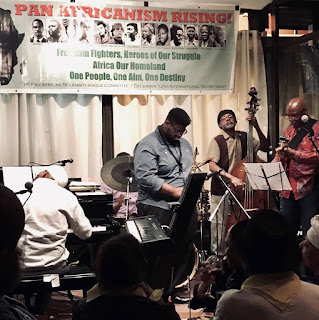RONNIE
BURRAGE: TRIBUTE TO HAMIET BLUIETT
May 25, 2019, Sista’s Place,
Brooklyn NY
Ronnie Burrage-drums, percussion, poetry, electronic keyboard,
voice; Kelvyn Bell-electric guitar,
voice; Donald Smith-piano, synthesizer; Darrell Mixon-upright bass; Kendrick Smith- straight alto saxophone,
soprano saxophone
Performance
review by John Pietaro
By the
time Ahmed Abdullah greeted the capacity crowd at Sista’s Place, it sizzled in anticipation
of this personal tribute to Hamiet Bluiett. Abdullah, who’d held Sun Ra’s
trumpet chair for decades, serves as Sista’s music director and reminded the
house that the late baritone saxophonist was a frequent performer at the Bedford-Stuyvesant
night spot. This favorite son of St. Louis made an impact far beyond state-lines
and generations, casting an art enraptured in African American culture and
pride.
The concert
was driven by drummer Ronnie Burrage, but a child when he first encountered
Bluiett via the Black Artists Group (BAG). The saxophonist was a founding member
of the legendary cultural activist organization and Burrage had come of age
within its programming. By design, the band held strong connections to both leader
and honoree: guitarist Kelvyn Bell followed Burrage to New York, circa 1978, and
they worked together for Bluiett, Arthur Blythe and others. Pianist/synthesizer
player Donald Smith is a veteran of various Oliver Lake ensembles, and bassist
Darrell Mixon, another old friend, traveled from St. Louis for this event. He
arrived in town with 28-year-old saxophonist Kendrick Smith, one of Bluiett’s
final students, a formidable talent brandishing a sound rising from his feet through
the length of his straight alto saxophone. Smith wields the horn’s lows masterfully,
casting melodic flights as singular as his choice of instrument. His solos,
cry-singing blue over fiery scarlet, inspired resounding applause that shook
the room (especially on Bluiett’s moving “Deb”), but such responses were not
limited to any one member of the band.
 |
| Left to right: Donald Smith, Ronnie Burrage (obscured), Kendrick Smith, Darrell Mixon, Kelvyn Bell. Photo by Pietaro |
Bell’s stinging, rapid, sustained
improvisations, classic by this time, were matched by a vocal with distinctive hand-manipulated
vibrato. Donald Smith’s piano, thunderous, impressionistic and compelling, drew
hollers, particularly on the band’s riveting take on “Oasis”, also an explosive
Burrage feature. The drummer’s tireless montuno improv peppered by crushing
accents threatened, it seemed, the very foundation of the club. But it was the woefully little-documented Mixon, he of high-end pizzicato runs and chop-heavy expansive techniques, that inspired
riotous responses and calls for “More!”. Judging by the crowd throughout the
set as well as the elation on stage, the spirit of Bluiett overwhelmed both the
space and celestial ground well above.













